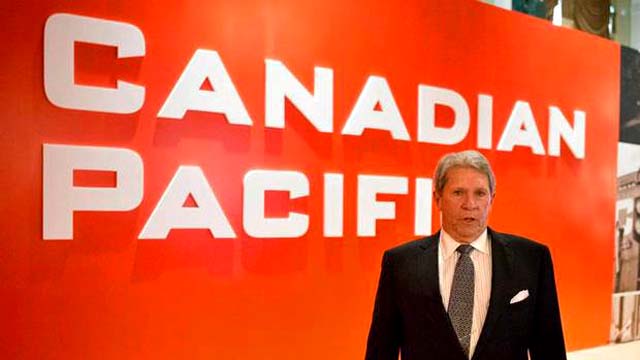|


CEO Hunter Harrison - Date unknown Chris Young.
2 May 2013
Canadian Pacific Wary of Betting on Oil
Toronto Ontario - Canadian Pacific Railway Ltd. isn't sure how long the growth in transporting crude oil by rail will last, so it will
stay cautious on its capital spending.
The Calgary-based railway's top executives said Wednesday it will spend cautiously to upgrade tracks and infrastructure used by crude shipments, even though CP
expects its number of carloads of crude to double from 70,000 this year to roughly 140,000 or more in 2015.
"It's going to be pretty dramatic," chief executive officer Hunter Harrison said at the company's annual general meeting Wednesday in
Toronto.
Yet with CP still in the middle of restructuring, its annual capital spending will remain in the relatively modest range of $1.1-billion, the same level as
outlined in its company-wide cost-cutting plans announced in early December.
An extra $50-million to $60-million could be added, although likely not much more, Mr. Harrison said.
Why the cautious spending? Mr. Harrison questions whether this growth in crude transportation will continue.
As he said to shareholders, there's no telling what the demand for crude-by-rail services will be in a few years, let alone a generation from now. "We're
not going to go out and spend capital and build an infrastructure that's going to last 40 or 45 years when we're not so sure how the crude-by-rail market will
be in five or six years," he said.
The company also sees crude-by-rail demand as just one piece in the puzzle to build CP's overall business across multiple sectors. In particular, the railway
will focus its current capital spending on a rail line between Edmonton and Winnipeg, which will help the transport of oil but also heavily benefit the
shipping of potash and grain.
"It's driven by crude, but it will also enhance the potash and grain coming off that line," Mr. Harrison said. The spending will be mainly on basic
track improvements, rail ties and ballast on the trackbed. Another line in North Dakota will receive much of the remaining capital spending. Together, these
lines will make up 85 percent to 90 percent of capital spending.
Rising demand for crude by rail has put a strong impetus on making these improvements now.
"Some of this is just moving up things that were in the multi-year plan in 2014 and 2015. Just accelerating and moving them up, because of our strong
cash-flow position," Mr. Harrison said.
Both Mr. Harrison and his successor-in-waiting, chief operating officer Keith Creel, said they don't envision possible regulatory approval of the Keystone XL
pipeline having an impact on CP's crude-by-rail business.
"I don't look at it as any risk. I think there's a place for both of us, potentially," Mr. Harrison said. "I think they have the ability to
execute and move crude very well. I think we offer some flexibility and some latitudes."
Meanwhile, Mr. Creel said that Keystone would target North-South demand down to the Gulf, whereas rail can exploit the East-West market, as well as provide
more nimbleness as demand changes between regions.
"Even if Keystone goes in," Mr. Creel said Wednesday, "it's only a fraction of demand that's needed there. So, there's space for both.
Keystone is the tip of the iceberg."
Guy Dixon.



Vancouver Island
British Columbia
Canada
|